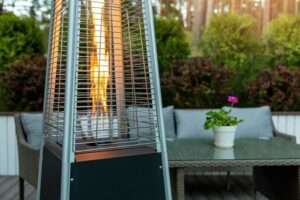Learn More About Your Propane Tank In Southeastern Wisconsin
 If you use propane in your southeastern Wisconsin home, you should know about your propane tank and how it operates.
If you use propane in your southeastern Wisconsin home, you should know about your propane tank and how it operates.
One feature you need to learn more about is the tank’s safety relief valve. All propane tanks, including the cylinders you use for your grill, are required by law to have pressure relief devices that allow for the release of excess pressure inside the tank.
The safety relief valve is designed to protect your propane tank from rupturing in case excess pressure builds up in the tank. It is also called a pop-off valve, pressure-venting valve, or a relief valve.
The safety relief valve is kept closed by a very strong spring as long as the pressure inside the tank is at a safe level. If the pressure in the tank reaches the same amount of pressure of the spring, the safety relief valve is opened. If that happens, you’ll hear a hissing sound coming from the tank as pressure is dissipated. In instances where the pressure in the tank is much higher than that of the spring, the valve will fully open. You’ll hear a pop if that occurs.
Once the pressure is down below the pressure of the spring, the valve closes on its own. If the valve pops open, it may need to be replaced. DO NOT attempt to repair or replace this on your own. This job requires a professional. Contact us to help.
What causes pressure to build up in a propane tank?
Propane is a liquid. It expands in the heat like water does. But propane’s expansion is much greater, 17 times that of water!
That’s why, when we deliver your propane, we fill your tank to 80% full. You may have noticed that and wondered if it was a mistake. It’s intentional. That remaining 20% of space in your tank remains empty so the propane has space to safely expand in warm or hot conditions.
What are the differences between an internal pressure relief valve and an external pressure relief valve?
Propane tanks use two main types of pressure relief valves (PRVs): internal and external pressure relief valves. Each type has its own purpose and benefits, making them essential for any propane system. Despite their small size, their impact on safety is significant.
Let’s go over each type of pressure relief valve so you better understand them.
Internal pressure relief valve: Internal PRVs are located inside propane tanks to provide extra protection against overpressure. These valves open when the tank’s pressure surpasses a set level, letting excess gas escape and reducing explosion risks.
Internal PRVs are often seen as more reliable than external ones because they are inside the tank, shielded from external damage and environmental factors, which helps them work well under various conditions. They are also less likely to be tampered with, offering a safer option for propane users.
A key benefit of internal PRVs is their quick response to pressure changes, providing immediate relief when needed. This swift action is essential for preventing accidents and ensuring propane system safety.
External pressure relief valve: External PRVs are mounted on the outside of the propane tank, where they are easily accessible for maintenance and inspection. Like their internal counterparts, external PRVs are designed to release excess pressure when it reaches a dangerous level, preventing accidents and ensuring the safety of the system.
One of the main benefits of external PRVs is their ease of access, which allows for regular maintenance and inspection. This accessibility makes it easier for propane users to ensure that their system is functioning properly and reduces the risk of malfunctions due to neglect.
External PRVs are also designed to withstand harsh environmental conditions, ensuring that they continue to function properly even in extreme weather. This durability is essential for maintaining a safe propane system, particularly in areas with challenging climates.
Safety measures for pressure relief valves
To ensure the safety of your propane system, it’s essential to follow safety best practices when it comes to both types of pressure relief valves. Regular inspections and maintenance are key to keeping your system working properly and preventing hazards.
Regular inspection is crucial for internal PRVs. Check the valve for damage or wear and make sure it’s functioning correctly. These inspections can spot issues early and help keep your propane system safe.
External pressure relief valves also need regular maintenance and inspection. Being outside the tank makes them more prone to environmental damage, so upkeep is crucial.
Whichever type of pressure relief valve your tank has, follow manufacturer guidelines for maintenance and replacement. This might include cleaning the valve, replacing worn parts, or adjusting pressure settings for optimal performance. Adhering to these guidelines maintains the safety and efficiency of your system.
Inspect your PRVs regularly for damage or wear, such as corrosion or leaks. Identifying problems early ensures your propane system stays safe and efficient.
Environmental factors can greatly affect the performance and lifespan of pressure relief valves. Knowing these factors helps propane users protect their systems and maintain safety and efficiency.
Temperature changes can alter pressure inside the propane tank, possibly causing overpressure and activating the pressure relief valve. In extreme temperatures, it’s crucial to closely monitor pressure levels and keep the system within safe limits.
Corrosion is another factor that can affect pressure relief valves, especially external ones. Regular inspections and maintenance can prevent corrosion and keep the valve working properly. Sometimes, using protective coatings or materials can help reduce corrosion risk and prolong the valve’s life.
Troubleshooting pressure relief valves
Pressure relief valves, though reliable, may still develop performance and safety issues. Knowing common problems and troubleshooting tips can help propane users keep their systems safe.
One frequent issue is leakage, often due to wear, corrosion, or incorrect installation. Regular checks and maintenance can catch leaks early.
Another issue is the valve not opening when pressure becomes unsafe. This might result from blockages, wrong pressure settings, or valve damage. Solutions could include cleaning the valve, adjusting settings, or replacing worn parts to ensure it works correctly.
For safe, expert propane tank installation, Boehlke Bottled Gas can’t be beat! Contact us today for your new propane tank. And don’t forget to ask about our reliable propane delivery!




